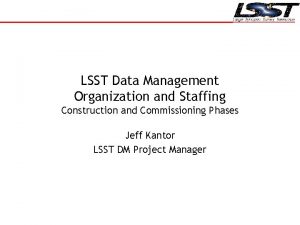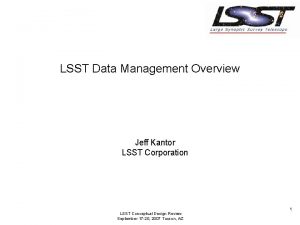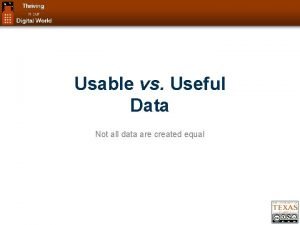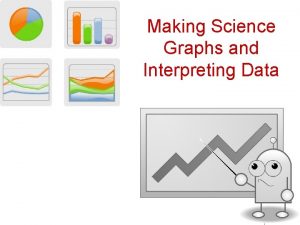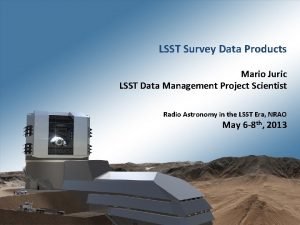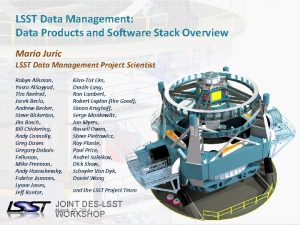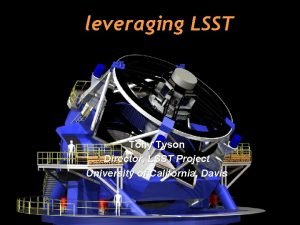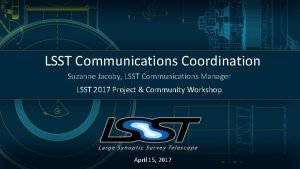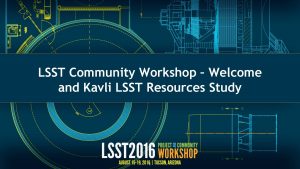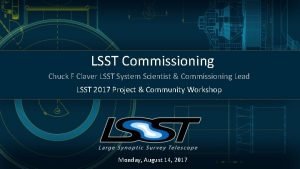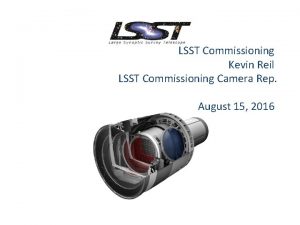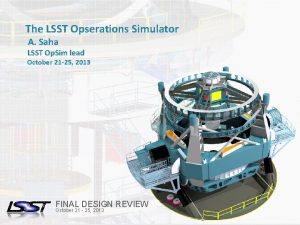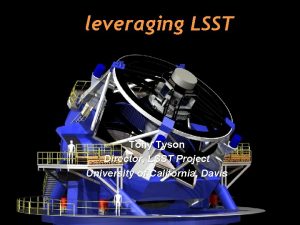Making LSST Data Products Useful The LSST Science











- Slides: 11

Making LSST Data Products Useful: The LSST Science Platform Mario Juric, University of Washington LSST Data Management Subsystem Scientist JOINT TECHNICAL MEETING 2017 March 6 -8 th, 2017 LSST JOINT TECHNICAL MEETING 2017 | GLENDALE, CA | MARCH 6 -8, 2017. Name of Meeting • Location • Date - Change in Slide Master 1

Key LSST Deliverables: The Data and a Way to Reach It The LSST will be a facility whose primary mission is to acquire, process, and make available to the data-rights holders the data collected by its telescope and camera. Our primary data products are the stream of events alerts (Level 1) and Data Release data products (Level 2). To make those products available and useful to the community, we’re building Data Access Centers. These will expose the LSST data to the data rights holders through a number of data access center services. LSST JOINT TECHNICAL MEETING 2017 | GLENDALE, CA | MARCH 6 -8, 2017. 2

LSST Portal: The Web Window into the LSST Dataset The Web Portal to the archive will enable browsing and visualization of the available datasets in ways the users are accustomed to at archives such as IRSA, MAST, or the SDSS archive, with an added level of interactivity. Through the Portal, the users will be able to view the LSST images, request subsets of data (via simple forms or SQL queries), construct plots, and generally explore the LSST dataset in a way that allows them to identify and access (subsets of) data required by their science case. Portal We’d like to have advanced features: use-case specific portals, advanced visualization, etc. (more discussion tomorrow) LSST JOINT TECHNICAL MEETING 2017 | GLENDALE, CA | MARCH 6 -8, 2017. 3

LSST Portal: The Web Window into the LSST Archive Portal The Firefly Web Science User Interface (Wu et al, 2016; ADASS) LSST JOINT TECHNICAL MEETING 2017 | GLENDALE, CA | MARCH 6 -8, 2017. 4

Next-to-the-data Analysis: Jupyter Notebooks The tools exposed through the Web Portal will permit simple exploration, subsetting, and visualization LSST data. They may not, however, be suitable for more complex data selection or analysis tasks. To enable that next level of next-to-the-data work, we plan to enable the users to launch their own Jupyter notebooks at our computing resources at the DAC. These will have fast access to the LSST database and files. They will come with commonly used and useful tools preinstalled (e. g. , Astro. Py, LSST data processing software stack). Portal Notebook This service is similar in nature to efforts such as Sci. Server at JHU, or the Jupyter. Hub deployment for DES at NCSA. LSST JOINT TECHNICAL MEETING 2017 | GLENDALE, CA | MARCH 6 -8, 2017. 5

Computing, Storage, and Database Resources Computing, file storage, and personal databases (the “user workspace”) will be made available to support the work via the Portal and within the Notebooks. Portal Notebook Computing Storage Database An important feature is that no matter how the user accesses the DAC (Portal, Notebook, or VO APIs) they always “see” the same workspace. LSST JOINT TECHNICAL MEETING 2017 | GLENDALE, CA | MARCH 6 -8, 2017. 6

How big is the “LSST Science Cloud” (@ DR 2)? − Computing: • ~2, 400 cores • ~18 TFLOPs − File storage: • ~4 PB − Database storage • ~3 PB This is shared by all users. We’re estimating the number of potential DAC users to be in the low 1000 s (relevant for file and database storage). Not all users will be accessing the computing cluster concurrently. A reasonable guess may be in 10 -100 range. Though this is a relatively small cluster by 2020 -era standards, it will be sufficient to enable preliminary enduser science analyses (working on catalogs, smaller number of images) and creation of some added-value (Level 3) data products. Think of this as having your own server with a few TB of disk and database storage, right next to the LSST data, with a chance to use tens to hundreds of cores for analysis. For larger endeavors (e. g. , pixel-level reprocessing of the entire LSST dataset), the users will want to use resources beyond the LSST DAC (more later). LSST JOINT TECHNICAL MEETING 2017 | GLENDALE, CA | MARCH 6 -8, 2017. 7

Open Sourcing the Software: Reproducibility and Algorithmic Insight As the final “piece of the puzzle”, we’re also be making available the source code of the LSST data processing software (and configurations used in processing). This will enhance reproducibility of the LSST data products, as well as provide source-code level of insight into algorithms utilized by LSST data processing. Having the source code may also enable community efforts extend apply the LSST codes to projects beyond the LSST. Some efforts, such as processing of HSC Survey data (Miyazaki et al. ) or of CFHT-LS (Boutigny et al. ), are already under way. LSST JOINT TECHNICAL MEETING 2017 | GLENDALE, CA | MARCH 6 -8, 2017. Software 8

Putting it all together: the LSST Science Platform Portal Notebook Computing Storage Database LSST JOINT TECHNICAL MEETING 2017 | GLENDALE, CA | MARCH 6 -8, 2017. Software 9

A different visualization LSST Science Platform Portal User Databases Notebooks User Storage User Computing TOOLS LSST Data Products: Images, Catalogs, Alerts Figure 1: A layered view of the LSST Science Platform. The LSST data will be exposed to the users through the web Portal, the Jupyter Notebook interface, and machine accessible APIs (not shown). The web Portal component will provide the essential data access and visualization services common to present day archives. The Notebook component, based on the Jupyter family of technologies (Jupyter. Hub and Jupyter. Lab) will allow for more sophisticated next-to-the-data analysis. These user-visible services will be supported by the user Database, Storage, Computing, and Tools components, enabling the users to access, sub-select, and perform added-value processing of all flavors of LSST Data Products LSST JOINT TECHNICAL MEETING 2017 | GLENDALE, CA | MARCH 6 -8, 2017. 10

How we (think) we will work with LSST data? − Most users are likely to begin with the Web Portal, to become familiar with the LSST data set and query smaller subsets of data for “at home” analysis. Some may use the tools they’re accustomed to (e. g. , TOPCAT, Aladin, Astro. Py, etc. ) to grab the data using LSST’s VOcompatible APIs. − Some users may choose to continue their analysis by utilizing resources available to them at the DAC. They’ll access these through Jupyter notebook-type remote interfaces, with access to a mid-sized computing cluster. It’s quite possible that a large fraction of end-user (“single PI”) science may be achievable this way. − For users who need larger resources, they may be able to apply for more resources at adjacent computing facilities. For example, U. S. computing is located in the National Petascale Computing Facility at the National Center for Supercomputing Applications (NCSA). Significant additional supercomputing is expected to be available at the same site (e. g. , NPCF currently hosts the Blue Waters supercomputer). − Finally, rights-holders may utilize their own computing facilities to support larger-scale processing. As they’re open source, they may re-use our software (pipelines, middleware, databases) to the extent possible. This is the system we’re all working to build! LSST JOINT TECHNICAL MEETING 2017 | GLENDALE, CA | MARCH 6 -8, 2017. 11


